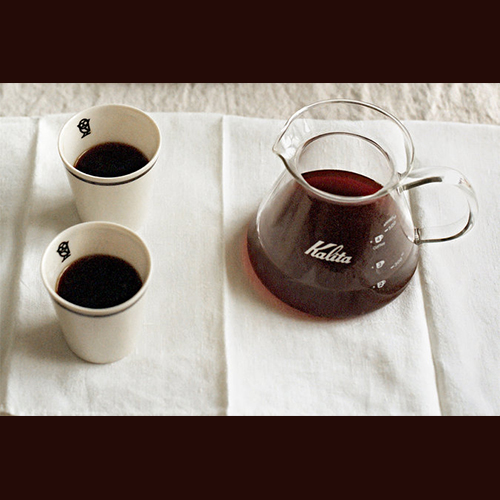 Lately, we’ve been enjoying experimenting with brewing techniques. While having great coffee (like the beans from Sasquatch) is obviously a must, we have found there are a number of ways you can make your morning coffee even more exceptional. Rather than a long list of brewing techniques, here is a 3-step guide for brewing:
Lately, we’ve been enjoying experimenting with brewing techniques. While having great coffee (like the beans from Sasquatch) is obviously a must, we have found there are a number of ways you can make your morning coffee even more exceptional. Rather than a long list of brewing techniques, here is a 3-step guide for brewing:
1. Grind Your BeansIf you buy only one new piece of coffee equipment, make it a grinder — the single most important tool in your kit. You can make nice coffee with a good grinder and an inexpensive brewer, but even the most advanced machine can’t do much with preground coffee sitting in a bag, and losing flavor as it is exposed to air. Grind the beans just before you brew, and the coffee will taste galaxies better.
Let’s get the bad news out of the way: A good grinder doesn’t come cheap. You want a burr grinder, which crushes coffee beans into regular-size particles (as opposed to an inexpensive blade grinder, which chops coffee beans into particles of varying sizes). The process of making coffee is one of extraction — you are using water to dissolve about 20 percent of what’s in the bean — and evenly ground beans mean an even extraction. When some grounds are powder-like and others are pebble-like, the coffee will be both over- and underextracted. (Underextracted coffee lacks flavor; overextracted is bitter and harsh.)
2. Use a Scale, Not a ScoopNow that “nerd” has gone from a slur to a compliment, it frees you to be more compulsive about how you make coffee. To start, coffee should be measured in grams, using a digital scale. It doesn’t have to be expensive. You can buy a perfectly functional digital scale for less than $15.
This suggestion shouldn’t be a surprise to anybody who has bought a baking cookbook recently. For years, pastry chefs have weighed their ingredients in grams, and now it’s standard for all corners of a restaurant kitchen. If you’ve baked using a digital scale, you know it is very easy to use and delivers better results with less mess or waste.
And it’s not just the coffee you should weigh. Ideally, you would also weigh your water, or at least measure volume in liters, rather than cups or ounces. Here’s why: When you brew coffee, you’re working with a ratio, a certain amount of coffee to water that you can scale up or down depending on how much you want to make. Most Americans do this with scoops and cups, meaning the cup measurements marked on the coffee machine. But a cup on a coffee machine is usually five ounces (not eight), and a scoop is arbitrary(there is no standard measurement). It’s a messy system.
If you are going to the trouble of creating that ratio every morning, you may as well do it right. A good benchmark is 55 grams of coffee to 1,000 grams (or one liter) of water, which is the Golden Cup Ratio of the Specialty Coffee Association of America. Don’t let the metric system scare you; it actually makes doing any math much easier.
As for the scale itself, an inexpensive one is all you need; be sure it has a capacity of at least two kilograms. But if you want to nudge open the door of coffee obsession, consider the Hario V60 scale ($60), which is accurate up to 0.01 of a gram, has a built-in timer and comes in Death Star matte black.
By the way, the best place to store beans is in a cool, dark, airtight place, and not in your grinder, which presumably sits out on the counter. Keeping the beans in the bag in a cabinet is fine. Take them out as needed, weigh them and then grind.
3. Graduate to a Better BrewerThere are two categories of coffee makers: manual brewers, which require you to heat the water and pour it over the grounds, and automatic brewers, which are appliances that do the heating and pouring for you.
Manual brewers have the advantage of being inexpensive. The Kalita Wave dripper ($35.95) is affordable, although the price climbs once you factor in filters ($12.95 for 100), a server ($24.95) and a pouring kettle ($107.95), which strictly speaking isn’t necessary but helps you finesse the water. The Hario V60 dripper ($23) is a little less expensive, and the Chemex 8-cup($39) is both a dripper and a handsome server that looks good on the breakfast table.
Manual brewers also allow you greater control of both the water temperature (it should be around 200 degrees Fahrenheit; cooler water doesn’t extract as well) and how the water hits the grounds. You can even streamline the process by putting the brewer directly on the scale so you can measure the hot water as you pour it in. Just watch the numbers on the scale climb.
But if you would rather have a machine do the work — no shame there — then you should look to one of the coffee makers that essentially replicates a manual brew. These appliances are superior to standard coffee machines because they are engineered to get the water hotter (the heating elements are better) and disperse it evenly so the grounds are fully saturated. And, as you can imagine, they are more expensive.
SRC: To read this entire article, originally published in the New York Times, click here: www.nytimes.com/interactive/2016/02/23/dining/how-to-make-coffee.html